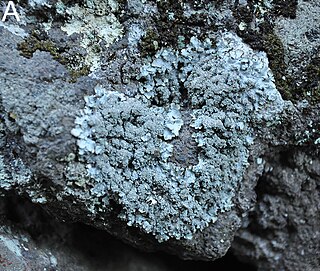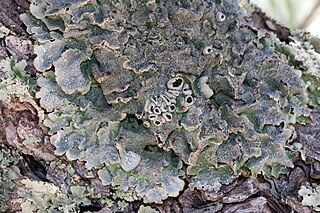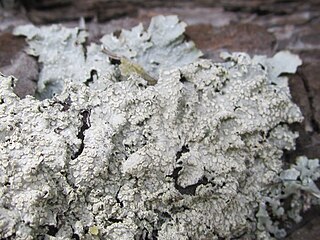
Melanelixia is a genus of foliose lichens in the family Parmeliaceae. It contains 15 Northern Hemisphere species that grow on bark or on wood. The genus is characterized by a pored or fenestrate epicortex, and the production of lecanoric acid as the primary chemical constituent of the medulla. Melanelixia was circumscribed in 2004 as a segregate of the related genus Melanelia.

Canoparmelia is a genus of lichen-forming fungi in the family Parmeliaceae. The widespread genus contains about 35 species. Canoparmelia, a segregate of the parmelioid lichen genus Pseudoparmelia, was circumscribed by John Elix and Mason Hale in 1986.
Canoparmelia cassa is a species of foliose lichen in the family Parmeliaceae. This species is characteristic by the occurrence of isidia together with fatty acids. It is similar externally to Canoparmelia amazonica. Its epithet cassa is derived from the Latin cassus, meaning "devoid", due to this species' lack of medullar reactive substances.
Hypotrachyna vainioi is a species of foliose lichen in the family Parmeliaceae. It is found in Brazil.
Bulbothrix meizospora is a species of foliose lichen in the family Parmeliaceae. It is found in Africa, Asia, and South America, where it grows on tree bark.

Punctelia guanchica is a species of foliose lichen in the family Parmeliaceae that is only known from the Canary Islands. It is similar in appearance and morphology to the North American Punctelia rudecta, and was historically misidentified as that species until molecular phylogenetic evidence showed it to be a distinct species. It differs in having thicker isidia that develop from the centre of the pseudocyphellae, and it mainly grows on rocks.
Punctelia transtasmanica is a species of foliose lichen in the family Parmeliaceae. It is found in Australasia.
Punctelia nashii is a species of foliose lichen in the family Parmeliaceae. It is known only from California.
Punctelia cedrosensis is a species of foliose lichen in the family Parmeliaceae. It is endemic to Mexico, where it grows on the bark of conifers.

Punctelia hypoleucites, commonly known as the southwestern speckled shield lichen, is a species of foliose (leafy) lichen in the family Parmeliaceae. First formally described by Finnish botanist William Nylander as a species of Parmelia, it was transferred to the genus Punctelia in 1982. The lichen is found in Africa, North America, and South America, where it grows on the bark of both hardwood and coniferous trees. Its greenish-grey thallus is covered with tiny white pseudocyphellae – minute holes in the thallus surface that facilitate gas exchange. Some macroscopic features that help distinguish this species from other related members of the genus include the presence and the structure of the apothecia, the absence of asexual surface propagules, and the light brown color of the thallus undersurface. Chemically, the presence of lecanoric acid in the medulla and atranorin in the cortex help distinguish it from lookalikes.

Punctelia bolliana, the eastern speckled shield lichen, is a species of foliose lichen in the family Parmeliaceae. It is found in North America, with a distribution extending from the Canadian province of Ontario south to the central and northeastern United States and Mexico. It grows on the bark of both deciduous trees and coniferous trees. The combination of characteristics that distinguishes this species from others in genus Punctelia are the absence of the vegetative propagules isidia and soralia, a pale brown lower thallus surface, and the presence of the secondary chemical protolichesterinic acid in the medulla.

Punctelia perreticulata is a widely distributed species of foliose lichen in the family Parmeliaceae. It occurs in Mediterranean Europe and Russia, North America, South America, Australia, and New Zealand, where it grows on rocks, bark, or wood. Its main distinguishing features are its thallus surface, marked with many shallow depressions, grooves, or pits, and sorediate pseudocyphellae. The lower side of the thallus is ivory to tan towards the centre and the major secondary metabolite in the medulla is lecanoric acid. A lookalike species with which it has been historically confused is Punctelia subrudecta; this lichen can be distinguished from Punctelia perreticulata by the texture of the thallus surface, or, more reliably, by the length of its conidia.
Pseudoparmelia kalbiana is a species of foliose lichen in the family Parmeliaceae. It is found in South America.
Psiloparmelia salazinica is a species of foliose lichen in the family Parmeliaceae. It is found in South America.
Xanthoparmelia perezdepazii is a species of saxicolous (rock-dwelling), foliose lichen in the family Parmeliaceae. It is found in the Canary Islands.

Pseudevernia consocians is a species of lichen in the family Parmeliaceae. It is found in both North America and Central America. Some characteristic features of Pseudevernia consocians are its well-developed, numerous isidia, relatively narrow lobes, and the presence of the lichen product lecanoric acid.
Canoparmelia consanguinea is a species of saxicolous (rock-dwelling), foliose lichen in the family Parmeliaceae. Found in Brazil, it was formally described as a new species in 2009 by lichenologists Marcelo Marcelli, Luciana da Silva Canêz, and John Elix. The type specimen was collected from an open field in Fazenda da Estrela at an altitude of 920 m (3,020 ft), where it was growing on basaltic rock.
Canoparmelia roseoreagens is a species of corticolous (bark-dwelling), foliose lichen in the family Parmeliaceae. Found in Brazil, it was formally described as a new species in 2009 by lichenologists Marcelo Marcelli, Luciana da Silva Canêz, and John Elix. The type specimen was collected from a Brazilian pine forest in Fazenda da Estrela at an altitude of 905 m (2,969 ft), where it was found growing on tree bark.
Parmotrema lawreyi is a species of corticolous (bark-dwelling), foliose lichen in the family Parmeliaceae. Found on the Galápagos Islands, it was formally described as a new species in 2019 by lichenologists Frank Bungartz and Adriano Spielmann. The type specimen was collected by the first author from the foothills of Media Luna on San Cristóbal Island, where it was found in dry, open woodland growing on the trunk of Bursera graveolens. The species epithet honours the authors' colleague James D. Lawrey, "on the occasion of his 70th birthday".
Parmotrema pustulotinctum is a rare species of foliose lichen in the family Parmeliaceae. Found on the Galápagos Islands, it was formally described s a new species in 2019 by lichenologists Frank Bungartz and Adriano Spielmann. The type specimen was collected from Santiago Island at an altitude of 362 m (1,188 ft), where it was found growing on an exposed vertical boulder. It is only known from the type collection. The species epithet refers to its isidia, that are pustulate and readily distinguishable from those of the closely related P. tinctorum.






